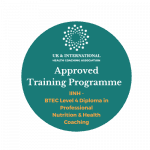There are about 60 million people with diabetes in the European Region, and levels among all ages mostly due to increases in overweight and obesity, unhealthy diet and physical inactivity. Diabetes is a leading cause of death worldwide and WHO projects diabetes deaths will double between 2005 and 2030 (source). Why is this happening? Can you cure diabetes? Is it genetic? So many questions for what is a big topic, too big to tackle with concrete answers. But in light of World Diabetes Day on November 14th, we’d like to shed light and explore some actionable steps you can take to use lifestyle and nutrition for diabetes.
If you are interested in learning more about nutrition check out our Nutrition & Health Coaching Course.
Nutrition for Diabetes Overview
Type 1 / Type 2 Diabetes
In Europe, it is estimated that there are 59.8 million people with diabetes. This number is expected to increase up to 71.1 million by 2040 (source). It’s important to outline that type I & type II diabetes are two very different things. Type 1 diabetes is an autoimmune condition that causes your cells to kill off your insulin-producing beta cells, as a result your body no longer makes insulin. With type 2 diabetes your body makes insulin but it isn’t used properly by the body or there is not enough insulin to meet your body’s demands resulting in an insulin inefficiency.
Although type 1 diabetes usually appears during childhood or adolescence, it can develop in adults. For the purpose of this section, we’re going to set it aside for the time being and focus on type 2 diabetes (see support section for more on type 1 diabetes).
Treatment
Type 1 diabetes requires intense daily self-management of insulin to balance food intake or exercise including multiple injections of insulin or infusion through an insulin pump. Managing type 2 diabetes includes daily self-management of food intake, exercise and medication. Over time roughly 40% may need to use insulin injections.
When you eat food, the body digests the macronutrients i.e. carbohydrates, proteins and fats.With carbohydrates specifically, the end product of digestion is glucose. This applies to all carbs be it fruit, dessert, candy, or soda. Once broken down, this glucose enters our bloodstream to be transported and moved into cells for use via insulin. Glucose is fuel for our body but if we eat too much, we get into problems. Despite being fuel, glucose is actually quite toxic in excess amounts.
Your bloodstream only ever has circa 4-5g of glucose in it at anyone time. When you eat a meal, you add anywhere from 0 up to 150grams into your bloodstream in one go. Your body then needs to process and get out of the blood as quickly as possible.
Pre-Diabetic
A 25-year study shows that incidence of type 1 diabetes is increasing by more than 3% per year in Europe (source). Type 2 diabetes is the most common type of diabetes and was once known as adult-onset diabetes. However, in recent years, the rate of type 2 diagnoses in children has been growing.
How did we end up in this mess? We have created the perfect storm for this diabetes epidemic, through a combination of genetic and modern environmental factors that drives this insulin resistance pattern above. As we continue to eat high carbohydrate diets and exercise less, the degree of insulin insensitivity increases. The road to type 2 diabetes follows this sequence….
Insulin resistance
Insulin is responsible for moving glucose from the blood into your cells and your liver. But here’s the catch; your cells and liver can only hold a certain amount of glucose. So when we eat too many carbs, the pancreas pumps insulin which tries to shuttle that glucose to the cells. If your cells and liver are full, these cells become resistant to insulin. So the glucose remains in the bloodstream. As the pancreas senses that there is too much glucose in the blood, it pumps even more insulin which causes the cells to become even more resistant (as excess insulin is also toxic). Eventually, this insulin shuttles the glucose to your fat cells to be stored as fat.
The road to type 2 diabetes
Levels of blood glucose remain high for longer as glucose cannot be channelled out. This in itself then contributes to the risk of cardiovascular disease (source) and causes systemic inflammation. Glucose continues to get stored as fat until eventually, even those cells may become resistant. Your pancreas thinks that “if some isn’t working, more would be better” and pumps more insulin. Repeated over and over and you eventually exhaust the pancreas and graduate to insulin-dependent Type 2 diabetes.
This pattern can affect other areas/systems in the body including muscle development, energy imbalance, weight, risk of cancer, thyroid and even nerve damage and sight loss. It’s worth mentioning that Type 3 diabetes is now a proposed term for Alzheimer’s disease resulting from insulin resistance (which is the primary problem associated with type 2 diabetes) and insulin deficiency (which the primary problem in type 1diabetes).
The good news, you can do something about this.
Nutrition strategies to prevent diabetes
Blood sugar levels
The first step is establishing your baseline. Diabetes diagnosis in both type 1 and type 2 is identified via a blood test. HbA1c measures the degree of glycation of your red blood cells’ haemoglobin. This means it’s essentially an indirect measure of how much blood sugar your cells are exposed to over time. The test seeks to establish the average level of blood sugar circulating through your body instead of tracking blood sugar numbers at one point in time (that rapidly fluctuate throughout the day, week, and month).
Carbohydrates
How Many Carbs Do We Really Need?
The current recommended daily allowance, or RDA, of carbohydrates, is set to 130 grams per day. But how many carbs do we need? The short answer: zero, provided that adequate amounts of protein and fat are consumed. It’s true. The only macronutrient that your body cannot survive without is actually protein. However, the amount of dietary carbohydrate that provides for optimal health in humans is unknown. We can imagine carb intake as a curve ranging from “allowable” to “desirable” to “unhealthy” subject to variables like age, current height and weight and particularly training volume.
How much sugar do we really need?
Again the answer is zero. But in today’s supermarket, sugar is actually quite hard to avoid. In fact, there are now over 50 different names for sugar to help hide it even better on a food label. Plus, manufacturers have gotten really good at making foods that encourage our sugar cravings.
According to WHO, we should limit our daily sugar intake to just 6 teaspoons a day or circa 24 grams (source). However, it is estimated that the average Briton consumes circa close to 22 teaspoons daily! To give some perspective, one 12oz can of coke has 39g of sugar.
About Carbohydrates: How Many
When it comes to diabetes prevention and support, less is inevitably better overall. There are a few things to consider:
- Some people can metabolize carbohydrates much better than others (genetics).
- The amount of carbs will depend on your training goal: performance, hypertrophy, muscle fullness, training intensity.
- You should consider the length of your training session and the type of training you are doing. Specifically, how much glycogen are you depleting and/or what energy systems are you using.
- Your body fat: the leaner (bodyfat /muscle) you are, the more carbs you can generally eat to maintain body composition.
- The health of your gut and insulin resistance/sensitivity: as a broad rule, overweight individuals tend to have lower insulin sensitivity meaning insulin has a harder job to try and get glucose into the cell. As you start to move more, exercise and transform your physique, your metabolism will change.
Practical Tips Type 1 & Type 2
Caveat: before reading the points below please note that while certain cases of type 2 diabetes can be reversed, type 1 diabetes is not reversible. So with the points below and their relation to type 1 diabetes, these are just suggestions to support and ideally reduce the amount of insulin required on a daily basis. We fully appreciate there is a lot more to type 1 diabetes and recommend speaking with your doctor too in order to develop the best strategy for your unique needs.
Diet Tips
Carbohydrate quality
Regardless of number, cutting back on carbohydrates, especially the obvious sugars and refined stuff is absolutely essential. Choose instead natural whole sources like vegetables, fruits, legumes, whole grains.
Food combining & GI index
When it comes to carbohydrates, the quantity and quality matters. The Glycemic index measures the impact a carbohydrate-containing food has on our blood sugar. Certain foods create a bigger rise in blood sugar relative to others. In general, whole food sources rich in fibre will have a lower rise in blood sugar. You can find multiple lists online. The general rule is to look to lower GI sources when possible and make use of high GI foods on certain occasions like post-workout. Be careful as these lists group all carbohydrate foods i.e. just because a junk food is low GI doesn’t mean it’s a free ticket to eat as much as you like.
Further to this, consuming high foods with an acidic ingredient (like vinegar, lemon) or with higher-fibre foods (like a salad of leafy greens), which lowers the glycemic response.
Vitamin D
Vitamin D is a vitamin (really it’s a hormone) we make from sunlight. Receptors can be found pretty much everywhere in the human body, indicating a connection with many processes in the body. However, most of us in the UK and other Western countries are deficient in Vitamin D. This is because of limited sunlight exposure due to reasons like more time spent at home, in the office or the car, shorter days in winter, sunscreen use in summer. Research suggests that Vitamin D may help improve the body’s sensitivity to insulin (source).
Breastfeeding
Breastfeeding has links to a lower risk of type 1 diabetes, type 2 diabetes, and obesity in offspring, and benefits for the mother as well, including a lower risk of metabolic syndrome and type 2 diabetes (source)
Consider lower carb
In general, research supports a lower carbohydrate diet to support both types of diabetes. With regards type 1 diabetes, for example, one study to mention found that after three months on an isocaloric low-carb diet (70-90 grams per day, with extra fat and protein to make up the missing calories), insulin requirements for insulin after meals dropped from 21.1 IUs to 12.7 IUs. After a full year, insulin requirements were even lower at 12.4 IUs per day. Total and HDL cholesterol remained the same, while triglycerides dropped.
Blood sugar balancing
Beyond just diabetes, blood sugar balancing is in the interest of any individual for health. The largest study to date of A1C levels and subsequent mortality risk confirmed that the higher subjects’ blood sugar, the greater their risk of mortality 4 years later.
As we’ve seen, eating meals high in carbohydrates affects our blood sugar. Our blood tried to maintain a very narrow range. When you send in a big additional load of glucose, certain organs kick in to manage that glucose and shuttle it out of the blood quickly. The havoc that this sugar rush set off, the swing of glucose and insulin, the cortisol and adrenaline, affects your health and your energy levels. For example, a hefty dose of sugar can compromise the immune system for more than 24 hours (source). Some simple suggestions to help keep blood sugar in the stable range:
- Eat every 4 hours
- Add protein to every meal
- Avoid refined sugar
- Focus on whole food sources of carbohydrates; fibre-rich foods, protein, and nutrient-dense sources of fat can help prevent blood sugar and insulin spikes and keep blood sugar levels at an even keel throughout the day.
- Eat low GI fruits, vegetables and grains
Lifestyle Tips
Stress
When you’re ‘stressed’, your sympathetic nervous system switches on. The response prioritizes the most essential functions for survival (perception, decision making, fuel for our muscles so we can run away or fight etc) while inhibiting non-essential functions (like reproduction, immunity, digestion, protein synthesis and bone formation). Chronic stress contributes to insulin resistance, mediated directly via the actions of cortisol and indirectly via increased inflammation that is also a feature of chronic stress. There are now epidemiological studies linking chronic stress with insulin resistance, supported by mechanistic studies showing that chronically elevated cortisol can cause diabetes. Cortisol suppresses insulin secretion from pancreatic beta cells, impairs insulin-mediated glucose uptake in cells throughout the body (by inhibiting GLUT-4), and by disruption of insulin signalling in muscle tissue (source).
Sleep
Altered sleep patterns disrupt circadian rhythms, which disrupts insulin sensitivity in type 1 diabetic youths (source). Not getting enough sleep can affect every system in the human body and increase the risk of nearly every chronic disease, including type 2 diabetes and insulin resistance. In fact, sleeping less than 6 hours per night increases the risk of type 2 diabetes by 50%. What might be even more fascinating is that there’s emerging evidence that the impact of sleep on insulin sensitivity and glucose metabolism is even greater than diet (source).
Exercise intelligently
Exercise is so critical for type 2 diabetics in regaining insulin sensitivity. It’s also the reason why endurance athletes can eat 400 or 600 grams of carbs a day and stay lean – they burn it all off and make room for more. Exercise helps improve insulin sensitivity through a direct action on the glucose transport molecules (GLUT-4 receptors) in the individual cells of our muscles. It also affects the full range of hormones related to accessing stored energy and regulating how that energy is used. (source). Resistance training seems to be as effective as aerobic activity, but a mix of the two is the best. Important amino acids and other vital nutrients have access to the cells when insulin sensitivity is high. So you’re building or maintaining muscle and losing fat weight.
Summary
So there you have it: nutrition strategies for diabetes.
Be sure to keep an eye out for World Diabetes Day November 14th.
WDD is the world’s largest diabetes awareness campaign reaching a global audience of over 1 billion people in more than 160 countries. The campaign draws attention to issues of paramount importance to the diabetes world and keeps diabetes firmly in the public and political spotlight (source).
If you are interested in learning more about nutrition check out our Nutrition Courses.











